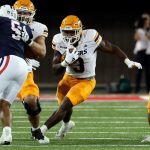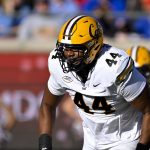Much has been made about Chris Getz’s desire to improve the team’s defense. On Tuesday the Chicago White Sox officially announced that they have agreed to a one-year deal worth $1.75 million with veteran shortstop Paul DeJong. Adam Hasley was designated for assignment in a corresponding move.
Defense will be especially important after the White Sox trade away their best pitcher Dylan Cease. The White Sox are going to have a rotation filled with question marks but having better defense, particularly up the middle should help alleviate some of that stress. It’s something that Getz alluded to during the GM meetings earlier in the month.
“In setting out to improve our defensive play, it will allow our pitchers to attack the zone and be more efficient. We need to become more athletic, and that speaks to the improved defense,” Getz said.
Yoan Moncada and Andrew Vaughn are seemingly locked at the corners. Meanwhile, Andrew Benintendi is getting paid the richest contract in franchise history to play left field. The only spots to improve the defense are in right field and up the middle. Right field still needs to be addressed.
Up the middle, the White Sox now have Korey Lee at catcher, DeJong, and Nicky Lopez as the double play at shortstop and second base, and Gold Glove finalist Luis Robert in center field.
So just how improved is the White Sox defense?
Catcher
Korey Lee did not look like an MLB-ready hitter when he arrived in Chicago after being traded from the Astros for Kendall Graveman. If Lee wants to stick around in the big leagues he is going to have to improve his approach at the plate, but his defense behind it may help him bide some extra time.
Lee had a 1.91 pop time last season which ranked in the MLB’s 81st percentile according to Baseball Savant. Opponents have been able to run all over the White Sox in recent years.
Last season, Yasmani Grandal had a pop time of 2.08, one of the worst in baseball. As a result, he allowed 98 stolen bases which was the third most in baseball. This stat is not all on the catchers. It is a pitcher’s responsibility to help hold runners on, but the slow pop time certainly didn’t help.
Lee was also in the top half of the league in Blocks Above Average. However, his overall Fielding Run Value was -1. This was the same as Grandal.
Lee had a much smaller sample size with just 35 games played last season. There is potential for him to be a solid backstop for the White Sox but he needs more time. Lee didn’t become a catcher until 2019 so he is still mastering the position. He is quicker and more athletic than the majority of catchers and has a rocket for an arm. Scouts graded his arm strength as a 70 on a 20-80 scale.
At the moment he is a slight upgrade for the White Sox on the defense side. But a slight upgrade does not justify his offensive numbers last season. He is going to need to get his swing figured out, but if can there is reason to believe he can develop into an above-average defender if given more time. But the White Sox should still be in the market for a catcher as the offseason rolls along.
Second Base
Nicky Lopez hasn’t produced much on the offense side throughout his career. But neither did the White Sox previous second baseman Elvis Andrus so Lopez’s only value will likely come from his glove.
Andrus was quietly a solid fielder for the White Sox but Lopez was even better for the Braves last season. Lopez had a Fielding Run Value of 8, which ranked in the 88th percentile. Last season Andrus had a Fielding Run-Value of 4 which ranked in the 77th percentile.
Lopez also proved to have an excellent range with a 9 Outs Above Average. That put him in the MLB’s 96th percentile. Andrus produced an OAA of 6, which was good enough to crack the 90th percentile.
Lopez was lacking a bit in arm strength but that won’t be much of a concern at second base, especially when you consider that Andrus’s arm strength graded even lower than Lopez’s.
The 28-year-old has always been an above-average defender. In 2021 he had a Fielding Run Value of 20. That year he also ranked third in the AL in double play and assists at shortstop. Lopez was tied for 10th in the MLB with 31 Outs Above Average since 2020.
He has proven time and time again to be a sure-hander defender who will certainly help out White Sox pitchers next season.
Shortstop
DeJong is the polar opposite of Tim Anderson. A power-hitting shortstop who does not hit for average and plays good defense.
Last season he had a Fielding Run Value of 7 which placed him in the MLB’s top 84th percentile. He also had nine Outs Above Average which placed him in the league’s 94th percentile. Anderson had a fielding run value of -30 which was the worst in baseball and a -1 OAA which placed him in the 31st percentile.
In 2019 DeJong led NL shortstops in assists, double plays turned, and fielding percentage. That same year Anderson led the MLB with 26 errors.
Anderson has a lot more upside as a hitter and a much better body of work. But since we are talking about defense this is the biggest upgrade that Getz has made this offseason. Time will tell if DeJong’s offensive deficiencies overshadow his defense.
Center Field
The center fielder is still the same but it should be noted just how good Luis Robert was last season.
Robert was tied with gold Glove winner Kevin Kiermaier, for the highest center field Outs Above Average in the American League at +13. That also placed Robert in the MLB’s top 98th percentile.
Taking an efficient route to the ball was one of the keys to Robert’s success. He recorded 370 putouts, the most by any outfielder in the MLB. His 2.81 Range Factor Per/9 innings, which measures the number of putouts and assists per inning played, was also the highest in the MLB.
Robert also recorded the most double plays from center field in the league and ranked in the top five in fielding percentage, Range Factor Per Game, and defensive games played in center field.
Not only did Robert excel on the stat sheet, he passed the eye test as well. Robert turned in a full reel of highly worthy plays throughout the season which included multiple home run robberies. One such play included a catch at the wall where Robert had to cover 102 feet of ground in 5.3 seconds to secure an out on a ball with a 5% catch probability.
With Robert roaming center field, White Sox pitchers should be in good hands.












